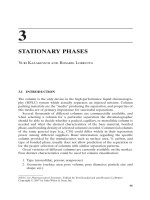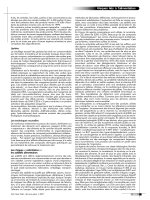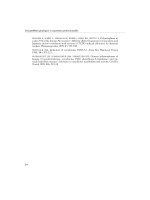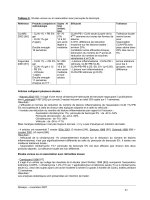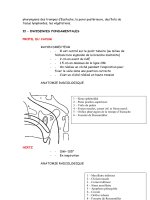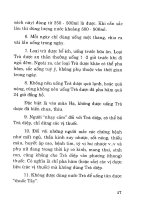CLINICIAN’S POCKET REFERENCE - PART 3 doc
Bạn đang xem bản rút gọn của tài liệu. Xem và tải ngay bản đầy đủ của tài liệu tại đây (376.74 KB, 77 trang )
1–5 mL in children); adequate volume will increase the detection rate. Be careful not to
touch the needle or the prepped skin site. Draw about 10 mL of blood. Remove the
tourniquet, and compress the venipuncture site and apply an adhesive bandage.
4. Discard the needle used in the puncture and replace it with a new, sterile 20–22-
gauge needle. Place the blood in each of the bottles by allowing the vacuum to draw in the
appropriate volume, usually specified on the collection device. Submit the samples to the
lab promptly with the appropriate lab slips completed including current antibiotics being
given.
Interpretation
Preliminary results are usually available in 12–48 h; cultures should not be formally re-
ported as negative before 4 d. A single blood culture that is positive for one of the following
organisms usually suggests contamination; however, on rare occasions these agents are the
causative pathogen: Staphylococcus epidermidis, Bacillus sp., Corynebacterium diphtheriae
(and other diphtheroids), Streptococcus viridans. Negative results do not rule out bac-
teremia, and false-positives can result for the contaminants noted. Gram-negative organ-
isms, fungi, and anaerobes are considered to be pathogenic until proven otherwise.
SPUTUM CULTURES
Cultures of sputum remain controversial. Many clinicians do not even order them and treat
only based on the Gram stain and clinical findings. One problem is that “sputum” samples
often contain only saliva. If you do a Gram stain on the specimen and see only a few squa-
mous cells, with many polys and histiocytes, the sample is good, and the culture will proba-
bly be reliable. Excessive numbers of squamous cells (see previous section on Gram stain)
suggests that the sample is more saliva than sputum. An early morning sample is most likely
to be from deep within the bronchial tree.
Steps to improve the quality of the sputum collection
1. Careful instructions to the patient.
2. If the patient cannot mobilize the secretions, P&PD along with nebulizer treatments
may help.
3 Careful nasotracheal suctioning using a specimen trap.
In general most labs will not accept anaerobic sputum cultures (critical in the diagnosis of
aspiration pneumonia and lung abscesses) unless obtained by transtracheal aspirate or en-
dobronchial endoscopic collection and submitted in special anaerobic transport media.
Viral, Legionella, Mycoplasma, and TB cultures require special culture materials available
at most labs. PCP can be diagnosed by sputum culture only about 10% of the time; there-
fore open-lung biopsy, endobronchial lavage, or other invasive techniques must be used to
demonstrate the organisms. Specialized staining techniques for identifying Pneumocystis
carinii include the methenamine silver, Giemsa, and toluidine blue stains.
STOOL CULTURES
Stool cultures are most often done to diagnose the cause of diarrhea or to identify disease
carriers. A fresh sample is essential to isolate the organisms. Most common pathogens (Sal-
monella, Shigella, enteropathogenic E. coli, etc) can be grown on standard media. Yersinia
and Campylobacter, however, usually require a special culture medium, and a special lab re-
quest is usually necessary.
A quick bedside test for bacterial causes of diarrhea is to check the stool for white cells
(fecal leukocyte smear) see page 128.
130 Clinician’s Pocket Reference, 9th Edition
7
Clostridium difficile Assay
Clostridium difficile is usually best diagnosed by determining the presence of C. difficile en-
terotoxin on the stool and not by culture. A positive C. difficile assay is found in the follow-
ing cases: >90% of pseudo-membranous colitis; 30–40% antibiotic associated colitis, and
6–10% cases of antibiotic-associated diarrhea.
Stool for Ova and Parasites
With toxic diarrhea, the possibility of parasitic disease must be considered and stool for
“ova and parasites” should be ordered. Protozoa (ameba [Entamoeba histolytica, others],
Blastocystis, Giardia) cannot be cultured and are identified by seeing mature, mobile organ-
isms or cysts on microscopic examination of freshly passed feces. Immunosuppressed (eg,.
HIV-positive) individuals may demonstrate Cryptosporidium, Microsporidia, and Strongy-
loides. The ova are most frequently identified in the stool of parasites such as nematodes
(Ascaris, Strongyloides), cestodes (Taenia, Hymenolepsis), and trematodes (Schistosoma).
THROAT CULTURES
Used to differentiate viral from bacterial (usually group A beta-hemolytic streptococci, eg,
Streptococcus pyogenes) pharyngitis.
Procedure
1. The best culture is obtained with the help of a tongue blade and a good light source.
2. If epiglottitis (croup) is suspected (stridor, drooling), a culture should not be at-
tempted.
3. The goal is to use the culture swab and try not to touch the oral mucosa or tongue, but
only the involved area. In the uncooperative patient, an arch-like swath touching both
the tonsillar areas and posterior pharynx should be attempted.
Many labs perform a specific “strep screen” to rapidly identify group A beta-hemolytic
streptococci. Normal flora on routine culture can include alpha-hemolytic strep, non-
hemolytic staph, saprophytic Neisseria species, Haemophilus, Klebsiella, Candida, and
diphtheroids.
Other pathogens can cause pharyngitis. If Neisseria gonorrhoeae is suspected, use the
Thayer–Martin medium. Diphtheria (C. diphtheriae) with its characteristic pseudo-mem-
brane, should be cultured on special media and the lab notified.
URINE CULTURES
As is true for sputum cultures, culturing for urinary tract pathogens is often controversial.
Some clinicians base their decision to treat only when the culture is positive, whereas others
rely on the presence of white blood cells or bacteria in the urinalysis, using cultures only for
sensitivities in refractory infections. The introduction of urine dipsticks to detect leukocytes
(by the detection of leukocyte esterase) aids in the decision making when cultures are not
obtained or are confusing. Routine cultures fail to diagnose other urinary tract pathogens
such as N. gonorrhea or Chlamydia.
A clean-catch urine (see Chapter 13, page 306) is about 85% accurate in women and
uncircumcised males. In general, a positive culture is a colony count of >100,000 bacte-
ria/mL of urine or a count from 10,000–100,000 bacteria/mL of urine in the presence of
pyuria. If the culture is critical for diagnosis, obtain an in-and-out catheterized urine (page
7 Clinical Microbiology
131
7
308) or suprapubic aspiration in children (page 309). Any growth of bacteria on an in-and-
out catheterized or suprapubic specimen is considered to represent a true infection.
If a urine specimen cannot be taken to the lab within 60 min, refrigerate it. The lab as-
sumes that more than three organisms growing on a culture represents a contaminant and the
specimen collection should be repeated. The exception occurs in patients with a chronic in-
dwelling Foley catheter that may be colonized with multiple bacterial or fungal organisms;
the lab should be told to “culture all organisms” in such cases.
VIRAL CULTURES AND SEROLOGY
The laboratory provides the proper collection container for the specific virus. Common
pathogenic viruses cultured include herpes simplex (from genital vesicles, throat), CMV
(from urine or throat), varicella-zoster (from skin vesicles in children with chickenpox and
adults with shingles), and enterovirus (rectal swab, throat).
For serologic testing, obtain an acute specimen (titer) as early as possible in the course
of the illness, and take a convalescent specimen (titer) 2–4 wk later. A fourfold or greater
rise in the convalescent titer compared with the acute titer indicates an active infection (see
Chapter 4 for selected viral antibody titers). With the development of PCR techniques,
biopsies performed on older lesions may yield useful information when cultures might be
negative.
SCOTCH TAPE TEST
Also known as a “pinworm preparation,” this method is used to identify infestation with En-
terobius vermicularis. A 3-in. piece of CLEAR Scotch tape is attached around a glass slide
(sticky side out). The slide is applied to the perianal skin in four quadrants and examined
under the microscope for pinworm eggs. The best sample is collected either in the early
morning prior to bathing or several hours after retiring.
MOLECULAR MICROBIOLOGY
Molecular techniques can now identify many bacterial and viral organisms without cultur-
ing. Many tests rely on DNA probes to identify the pathogens. The following includes some
microbes commonly identified from clinical specimens (ie, swab, serum, tissue). Availabil-
ity varies with each clinical facility.
Common Microorganisms Identifiable by PCR/DNA Probe
• Chlamydia trachomatis
• Borrelia burgdorferi (Lyme disease)
• HIV
• Mycoplasma pneumoniae
• Mycobacterium tuberculosis
• Neisseria gonorrhoeae
• Hepatitis B
• HPV
• Many others under development
132 Clinician’s Pocket Reference, 9th Edition
7
SUSCEPTIBILITY TESTING
To more effectively treat a specific infection by choosing the right antibiotic, many labs rou-
tinely provide the MIC or MBC. For more complex infections (endocarditis), Schlichter
testing is sometimes used.
MIC (Minimum Inhibitory Concentration)
This is the lowest concentration of antibiotic that prevents an in vitro growth of bacteria.
The organism is tested against a battery of antimicrobials in concentrations normally
achieved in vivo and reported as
Susceptible (S): The organism is inhibited by the agent in the usual dose and route, and
the drug should be effective.
Intermediate (I): Sometimes also reported as “indeterminate,” this implies that high
doses of the drug, such as those achieved with parenteral therapy (IM, IV), most likely in-
hibit the organism.
Resistant (R): The organism is resistant to the usual levels achieved by the drug.
MBC (Minimum Bactericidal Concentration)
Similar to the MIC, but indicates the lowest antibiotic concentration that will kill 99.9% of
the organisms. The MBC results in killing the organisms, and the MIC prevents growth but
may not kill the organism.
Schlichter Test (Serum Bacteriocidal Level)
Used to determine the antibacterial level of the serum or CSF of patients who are receiving
antibiotic therapy. The test uses eight serial dilutions of the patient’s serum (1:1 through
1:128) to determine what dilution is bactericidal to the infecting organism. The test is usu-
ally coordinated by the departments of infectious disease and microbiology. One set of
blood or CSF cultures must be negative for the infecting organism before the test is per-
formed. Opinion varies greatly as to interpretation of the results. Optimal killing of the or-
ganism occurs at dilutions of blood (and CSF) ranging anywhere from a trough of 1:4 to a
peak of 1:8. That is, a result such as “S. aureus bactericidal level = 1:8” means the infecting
organism was killed at a serum dilution of 1:8. Some data suggest higher titers (1:32) are
needed to treat bacterial endocarditis. For the test to be performed, the organisms responsi-
ble for the infection must be isolated from a patient specimen.
DIFFERENTIAL DIAGNOSIS OF COMMON INFECTIONS AND
EMPIRIC THERAPY
The pathogens causing common infectious diseases are outlined in Table 7–2 along with
some empiric therapeutic recommendations. The antimicrobial drug of choice for the treat-
ment of infection is usually the most active drug against the pathogenic organism or the
least toxic alternative among several effective agents. The choice of drugs is modified by the
site of infection, clinical status (allergy, renal disease, pregnancy, etc), and susceptibility
testing.
Tables 7–3 through 7–7 provide empiric treatment guidelines for some common infec-
tious diseases, including bacterial, fungal, viral, HIV, parasitic, and tick-borne diseases.
7 Clinical Microbiology
133
7
7
TABLE 7–2
Organisms Responsible for Common Infectious Diseases with Recommended Empiric Therapy*
Site/Condition
Common
Common Empiric Therapy
Uncommon but Important
(Modify based on clinic factors such as
Gram stain)
BONES AND JOINTS
Osteomyelitis
Staphylococcus aureus
Oxacillin, nafcillin
Enterobacteriaceae
If nail puncture: Pseudomonas
spp.
Joint, septic arthritis
S. aureus
Oxacillin; ceftriaxone if gonococci
Group A strep
Enterobacteriaceae
Gonococci
Joint, prosthetic
S. aureus, S. epididymis,
Vancomycin plus ciprofloxacin
Streptococcus
spp.
BREAST
Mastitis, postpartum
S. aureus
Cefazolin, nafcillin, oxacillin
BRONCHITIS
In adolescent/young patient:
Treatment controversial because most infections
Mycoplasma pneumoniae
are viral; treat if febrile, or associated with
Respiratory viruses
sinusitis, positive sputum culture in patients
In chronic adult infection:
with COPD or if duration
>7 days; doxy-
Streptococcus pneumoniae
cycline, erythromycin, azithromycin,
Haemophilus influenzae
clarithromycin
M. catarrhalis
Chlamydia pneumoniae
(continued
)
134
7
TABLE 7–2
(Continued)
Site/Condition
Common
Common Empiric Therapy
Uncommon but Important
(Modify based on clinic factors such as
Gram stain)
CERVICITIS
Chlamydia, M. hominis,
Azithromycin single dose, doxycycline
(nongonococcal)
Ureaplasma,
others
(evaluate and treat partner)
CHANCHROID
Haemophilus ducreyi
Ceftriaxone or azithromycin as single dose
CHLAMYDIA
Urethritis, cervicitis, conjunctivitis,
Chlamydia trachomatis
Azithromycin, doxycycline (amoxicillin if
proctitis
pregnant)
Neonatal ophthalmia, pneumonia
Erythromycin
Lymphogranuloma
C. trachomatis (specific serotypes, Doxycycline
venereum
L1, L2, L3)
DIVERTICULITIS
Enterobacteriaceae, enterococci, TMP–SMX, ciprofloxacin plus metronidazole
(no perforation or peritonitis)
bacteroids
EAR
Acute mastoiditis
S. pneumoniae
Amoxicillin, ampicillin/clavulanic acid,
Group A strep
cefuroxime
S. aureus
Chronic mastoiditis
Polymicrobial: Anaerobes
Ticarcillin/clavulanic acid, imipenem
Enterobacteriaceae
Rarely: M. tuberculosis
Otitis externa (swimmer’s ear)
Pseudomonas
spp.
Topical agents such as Cortisporin otic,
Enterobacteriaceae
TobraDex
(continued
)
135
7
TABLE 7–2
(Continued)
Site/Condition
Common
Common Empiric Therapy
Uncommon but Important
(Modify based on clinic factors such as
Gram stain)
EAR
Otitis externa (continued)
In diabetic or malignant otitis:
Malignant otitis externa: acutely aminoglycoside,
Pseudomonas
spp.
plus ceftazidime, imipenem or piperacillin
Otitis media
S. pneumoniae, H. influenzae,
Amoxicillin, ampicillin/clavulanic acid,
M. catarrhalis, viral causes
cefuroxime
S. aureus,
group A strep
In nasal intubation:
Enterobacteriaceae,
Pseudomonas
spp.
EMPYEMA
S. pneumoniae, S. aureus
Cefotaxime, ceftriaxone
ENDOCARDITIS
Native valve
S. viridans
Parenteral: penicillin or ampicillin plus oxacillin
S. pneumoniae
or nafcillin plus gentamicin; vancomycin
Enterococci
plus gentamicin
S. bovis
IV drug user
S. aureus
Nafcillin plus gentamicin
Pseudomonas
spp.
Prosthetic valve
If early (<6 mo after implant)
Vancomycin plus rifampin plus gentamicin
S. epidermidis
S. aureus
Enterobacteriaceae
(continued
)
136
7
TABLE 7–2
(Continued)
Site/Condition
Common
Common Empiric Therapy
Uncommon but Important
(Modify based on clinic factors such as
Gram stain)
Prosthetic valve (continued)
If late (
>6 mo after implant)
S. viridans
Enterococci
S. epidermidis
S. aureus
EPIGLOTTITIS
H. influenzae
Chloramphenicol plus ceftriaxone, cefotaxime
S. pneumoniae
or ampicillin
S. aureus
Group A strep
GALL BLADDER
Cholecystitis
Acute: E. Coli, Klebsiella,
Ampicillin plus gentamicin w/wo metronidazole,
Enterococcus
imipenem
Chronic obstruction: anaerobes,
coliforms, Clostridium
Cholangitis
E. coli, Klebsiella, Enterococcus
GASTROENTERITIS
Afebrile, no gross blood or no Virus, mild bacterial infection
Supportive care only
WBC in stool
Febrile, gross blood, and WBC Enteropathogenic
E. coli
Empiric treatment pending cultures:
in stool
Shigella
ciprofloxacin, norfloxacin
Salmonella
(continued
)
137
7
TABLE 7–2
(Continued)
Site/Condition
Common
Common Empiric Therapy
Uncommon but Important
(Modify based on clinic factor such as
Gram stain)
Febrile gastroenteritis (continued)
Campylobacter
Vibrio
C. difficile
L. monocytogenes
GRANULOMA INGUINALE
Calymmatobacterium granulomatis
Doxycycline, trimethoprim/sulfamethoxazole
GONORRHEA
N. gonorrhea
Cefixime, ciprofloxacin, ofloxacin,
(urethra, cervix, rectal,
ceftriaxone all as single dose; (treat also
pharyngeal)
for Chlamydia)
MENINGITIS
(Empiric therapy before cultures)
Neonate
Group B strep,
E. coli, Listeria
Ampicillin plus cefotaxime
monocytogenes
Infant 1–3 mo
S. pneumoniae
N. meningitidis
Child/adult, community acquired
S. pneumoniae
Vancomycin plus ceftriaxone
N. meningitidis, H. influenzae
Postoperative or traumatic
S. epidermitis, S. aureus,
Vancomycin plus ceftazidime
S. pneumoniae, Pseudomonas
Immunosuppressed (ie steroids) Gram-negative bacilli,
L. monocytogenes
Ampicillin plus ceftazidime
History of alcohol abuse
S. pneumoniae
Ampicillin plus ceftriaxone or cefotaxime
N. meningitidis, gram-negative bacilli
(continued
)
138
7
TABLE 7–2
(Continued)
Site/Condition
Common
Common Empiric Therapy
Uncommon but Important
(Modify based on clinic factors such as
Gram stain)
Meningitis (continued)
Pseudomonas
spp.
H. influenzae
HIV infection
Cryptococcus
Amphotericin B (acutely), fluconazole
NOCARDIOSIS
Nocardia asteroides
Sulfisoxazole, TMP–SMX
PELVIC INFLAMMATORY DISEASE
Gonococci
Ofloxacin and metronidazole or ceftriaxone
Enterobacteriaceae
(single dose) plus doxycycline; parenteral
Bacteroides
spp.
cefotetan or cefoxitin plus doxycycline
Chlamydia
Enterococci
M. hominis
PERITONITIS
Primary (spontaneous)
S. pneumoniae
Cefotaxime or ceftriaxone
Enterobacteriaceae
Secondary to (bowel
Enterobacteriaceae,
Bacteroides
spp. Suspect small bowel: piperacillin, mezlocillin,
perforation, etc)
Enterococci
meropenem, cefoxitin
Pseudomonas
spp.
Suspect large bowel: clindamycin plus
aminoglycoside
Peritoneal dialysis-related
S. epidermidis
Based on culture
S. aureus
Enterobacteriaceae
Candida
(continued
)
139
7
TABLE 7–2
(Continued)
Site/Condition
Common
Common Empiric Therapy
Uncommon but Important
(Modify based on clinic factors such as
Gram stain)
PHARYNGITIS
Respiratory virus
Exudative (group A strep): benzathine penicilllin
Group A strep
G, erythromycin, loracarbef, azithromycin
Gonococci
C. diphtheria
Epstein–Barr virus (infectious
mono); spirochetes, anaerobes
PNEUMONIA
Neonate
Viral (CMV, herpes), bacterial
Ampicillin or nafcillin plus gentamicin
(group B strep, L. monocytogenes,
coliforms, S. aureus, Chlamydia)
Infant (1–24 mo)
Most viral such as RSV;
S. pneumonia,
Cefuroxime; if critically ill, cefotaxime,
Chlamydia, Mycoplasma
ceftriaxone plus cloxacillin
Child (3 mo– 5 y)
As above Erythromycin, clarithromycin; if critically
ill, cefuroxime plus erythromycin
Child (5–18 y)
Mycoplasma,
respiratory viruses, Clarithromycin, azithromycin; er
ythromycin
S. pneumoniae, C. pneumoniae
Adult community-acquired
M. pneumoniae, C. pneumoniae,
Clarithromycin, azithromycin
S. pneumoniae
If hospitalized, third-generation cephalosporin
Smokers: As above plus
plus erythromycin or azithromycin
M. catarrhalis, H. influenzae
(continued
)
140
7
TABLE 7–2
(Continued)
Site/Condition
Common
Common Empiric Therapy
Uncommon but Important
(Modify based on clinic factors such as
Gram stain)
Adult, community-acquired
S. pneumoniae
oral flora, including Clindamycin
aspiration
anaerobes
(eg, Fusobacterium, Bacteroides
sp.)
Enterobacteriaceae
Adult hospital-acquired or
S. pneumonia,
coliforms,
Imipenem, meropenem
ventilator-associated
Pseudomonas, Legionella
HIV-associated
Pneumocystis
Pneumocystis: TMP–SMX; may require steroids
Others as above
TB, fungi
SINUSITIS
S. pneumoniae
Acute: TMP-SMX ampicillin, amoxicillin/
H. influenzae
clavulanic acid, ciprofloxacin, clarithromycin
M. catarrhalis
Anaerobes
In nosocomial, nasal intubations, etc:
S. aureus
Pseudomonas
spp.
Enterobacteriaceae
SKIN/SOFT TISSUE
Acne
Propionibacterium acne
Tetracycline, minocycline, topical clindamycin
Acne rosacea
Possible skin mite
Topical: metronidazole, doxycycline
Burns
S. aureus,
Enterobacteriaceae,
Topical: silver sulfadiazine
(continued
)
141
TABLE 7–2
(Continued)
Site/Condition
Common
Common Empiric Therapy
Uncommon but Important
(Modify based on clinic factors such as
Gram stain)
Burns (continued)
Pseudomonas, Proteus
Sepsis: Aztreonam or tobramycin plus
Herpes simplex virus, Providencia,
cefoperazone, ceftazidime or piperacillin
Serratia, Candida
Bite (human and animal)
Anaerobes
Ampicillin/sulbactam IV or amoxicillin/
P. multiloculada
clavulanic acid PO
Cellulitis
Streptococcus
spp. (group, A. B. C, G) Diabetic: nafcillin, oxacillin with or
S. aureus
without penicillin; if anaerobic, high-dose
Anaerobic
penicillin G, cefoxitin, cefotetan
Decubitus
Group A strep (S. pyogenes)
If acutely ill: imipenem, meropenem,
Anaerobes, S. aureus,
ticarcillin/clavulanic acid
Enterobacteria
Polymicrobial anaerobic
Erysipelas
Group A strep (S. pyogenes)
Nafcillin, oxacillin, dicloxacillin, cefazolin
Impetigo
Group A strep
Penicillin, erythromycin; oxacillin or
S. arueus
nafcillin if S. aureus
Tinea capitis (scalp)
Fungus: Trichophyton
spp.,
Terbinafine, itraconazole, fluconazole,
“ringworm”
Microsporum
spp.
Tinea corporis (body)
Fungus:
Trichophyton
spp.,
Topical: ciclopirox, clotrimazole, econazole,
Epidermophyton
ketoconazole, miconazole, terconazole,
others
Tinea unguium
Various fungi
Itraconazole, fluconazole, terbinafine
7
(continued
)
142
7
TABLE 7–2
(Continued)
Site/Condition
Common
Common Empiric Therapy
Uncommon but Important
(Modify based on clinic factors such as
Gram stain)
SYPHILIS
Treponema pallidum
Benzathine penicillin G one dose;
(less than 1 y duration)
doxycycline, tetracycline, ceftriaxone
TUBERCULOSIS
Mycobacterium tuberculosis
Pulmonary, HIV (
−)
INH, rifampin ethambutol plus
pyrazinamide at least 6 mo (+/−
pyridoxine)
TB exposure, PPD (−)
Children <5 INH X3 mo (+/−
pyridoxine),
others observe
Prophylaxis in high-risk
INH 6–12 mo (+/−
pyridoxine)
patients (diabetics, IV
drug users, immuno-
suppressed, etc)
PPD + conversion
INH 6–12 mo (+/−
pyridoxine)
URINARY TRACT INFECTIONS
Cystitis
Enterobacteriaceae
Quinolone, TMP–SMX
(E. coli most common)
S. saprophyticus
(young female)
Candida
Candida: fluconazole or amphotericin B
bladder irrigation
Urethritis
Gonococci,
C. trachomatis,
Ceftriaxone, cefixime, ciprofloxacin,
Trichomonas
ofloxacin (all one dose) plus
(continued
)
143
7
TABLE 7–2
(Continued)
Site/Condition
Common
Common Empiric Therapy
Uncommon but Important
(Modify based on clinic factors such as
Gram stain)
Urethritis (continued)
Herpesvirus
azithromycin (single dose) or doxycycline
Ureaplasma urealyticum
(treat partner)
Prostatitis, acute <35 y
C. trachomatis
Ofloxacin
Gonococci
Coliforms
Cryptococcus (AIDS)
Prostatitis, acute >35 y
Coliforms
Quinolone, TMP–SMX; if acutely ill
gentamicin/ampicillin IV
Prostatitis, chronic
Coliforms, enterococci,
Long-term ciprofloxacin or ofloxacin
bacterial
Pseudomonas
Pyelonephritis
Enterobacteriaceae
If acutely ill, gentamicin/ampicillin IV;
(E. coli)
quinolone, TMP–SMX
Enterococci
Pseudomonas
spp.
ULCER DISEASE
Helicobacter pylori
Omeprazole plus amoxicillin plus
(duodenal or gastric,
clarithromycin
not NSAID related)
VAGINA
Candidiasis
C. albicans
Fluconazole, itraconazole
C. glabrata, C. tropicalis
(continued
)
144
7
TABLE 7–2
(Continued)
Site/Condition
Common
Common Empiric Therapy
Uncommon but Important
(Modify based on clinic factors such as
Gram stain)
Trichomonas
Trichomonas vaginalis
Metronidazole (treat partner)
Vaginosis, bacterial
Polymicrobial (
Gardnerella
Metronidazole (PO or vaginal gel);
vaginalis, Bacteroides, M. hominis
clindamycin, PO or intravaginally
*All antimichrobial therapy should be based on complete clinical data, including results of Gram’
s stains and cultures. See also Tables 7–3 (V
iral), 7–4 (HIV),
7–5 (Fungal), and 7–6 (Parasitic) 7–7 (Tick-Bor
ne).
Note: These guidelines are based on agents commonly involved in adult infections. Actual microbial treatment should be guided by micr
obiologic studies inter-
preted in the clinical setting.
Abbreviations: AIDS = acquired immunodeficiency syndrome; COPD = chronic obstructive pulmonar
y disease; HIV = human immunodeficiency virus; IN
H =
isoniazid; IV = intravenous; NSAID = nonsteroidal antiinflammator
y drug; PO = by mouth; PPD = purified protein derivative; TB =
tuberculosis; TMP–SMX =
trimethoprim–sulfamethoxazole.
145
7
TABLE 7–3
Pathogens and Drugs of Choice for Treating Common V
iral Infections*
Viral Infection
Drug of Choice
Adult Dosage
CMV
Retinitis, colitis, esophagitis Ganciclovir (
Cytovene)
†
5 mg/kg IV q12h ×
14–21d, 5 mg/kg/d IV or 6 mg/kg
IV 5×/wk or 1 g PO tid
(Vitrasert) implants
4.5 mg intraocularly q 5–8 mo
or Foscarnet (
Foscavir)
60 mg/kg IV q8h or 90 mg/kg IV q1–2 h x 14–21 d
followed by 90–120 mg/kg/d IV
or Cidofovir (Vistide)
5 mg/kg/wk IV
×
2 wk, then 5 mg/kg IV q2 wk
or Fomivirsen (Vitravene) 330 µg intravitreally q2 wk
× 2 then 1/mo
EBV
Infectious mononucleosis
None
HAV
None, but gamma globulin 0.2 mL/kg IM
× 1
within 2 wk of exposure
may limit infection
HBV
Chronic hepatitis
Lamivudine (Epivir HBV)
100 mg PO 1×/d ×
1–3 y
Interferon alfa-2b (
Intron A) 5 million units/d or 10 million units 3
×/wk SC
or IM ×
4 mo
HCV
Chronic hepatitis
Interferon alfa-2b plus
3 million units 3
×/wk SC plus ribavirin
Ribavirin (Rebetron)
1000–1200 mg/d PO ×
12 mo
Interferon alfa-2b (
Intron A) 3 million units SC or IM 3x/wk
× 12–24 mo
Interferon alfa-2a (
Roferon-A) 3 million units SC or IM 3x/wk
×
12–24 mo
(continued
)
146
7
TABLE 7–3
(Continued)
Viral Infection
Drug of Choice
Adult Dosage
Chronic hepatitis (continued) Interferon alfacon-1 (
Infergen)9
µg 3×/wk ×
6 mo
HSV
Orolabial herpes in the
Penciclovir (
Denavir)
1% cream applied q2h while awake
× 4 d
immunocompetent with
multiple recurrences
Genital herpes
first episode
Acyclovir (Zovirax)
400 mg PO tid or 200 mg PO 5×/d ×
7–10 d
or Famciclovir (
Famvir)
250 mg PO tid ×
5–10 d
or Valacyclovir (
Valtrex) 1 g PO bid ×
7–10 d
recurrence
Acyclovir (
Zovirax)
400 mg PO tid ×
5 d
or Famciclovir (
Famvir)
125 mg PO bid ×
5 d 17
or Valacyclovir (
Valtrex) 500 mg PO bid ×
5 d
chronic suppression
Acyclovir (
Zovirax)
400 mg PO bid
or Valacyclovir (
Valtrex) 500–1000 mg PO 1×/d
or Famciclovir (
Famvir)
250 mg PO bid
Mucocutaneous in the
Acyclovir (
Zovirax)
5 mg/kg IV q8h ×
7–14 d
immunocompromised
or Acyclovir (
Zovirax)
400 mg PO 5x/d ×
7–14 d
Encephalitis
Acyclovir (Zovirax)
10–15 mg/kg IV q8h ×
14–21 d
Neonatal
Acyclovir (
Zovirax)
20 mg/kg IV q8h ×
14–21 d
Acyclovir-resistant
Foscarnet (
Foscavir)
40 mg/kg IV q8h ×
14–21 d
Keratoconjunctivitis
Trifluridine (Viroptic)
1 drop 1% solution topically, q2h, up to 9 gtt/d
× 10 d
HIV (See Table 7–4)
INFLUENZA A AND B VIRUS
Zanamivir (Relenza)
10 mg bid ×
5d by inhaler
Oseltamivir (Tamiflu)
75 mg PO bid ×
5 d
(continued
)
147
7
TABLE 7–3
(Continued)
Viral Infection
Drug of Choice
Adult Dosage
INFLUENZA A VIRUS
Rimantadine (Flumadine
)
200 mg PO 1×/d or 100 mg PO bid ×
5 d
Amantadine (Symmetrel)
100 mg PO bid ×
5 d
MEASLES
Children
None (immunize, See Table 22–9)
Adults
None or ribavirin
20–35 mg/kg/d ×
7 d
PAPILLOMA VIRUS (HPV)
Anogenital warts
Podofilox or podophyllin
Topical application (see Chapter 22)
Interferon alfa-2b
(Intron A) 1 million units intralesional 3
×/wk × 3 wk
Imiquimod, 5% cream (
Aldara) Apply 3/wk hs, remove 6–10 h later up to 16 wk
RSV
(bronchiolitis)
Ribavirin (Virazole)
Aerosol treatment 12–18 h/d ×
3–7 d
VZV
Exposure prophylaxis in the VZIG, Varicella Zoster Immune
See package insert
immunocompromised
Globulin
(HIV, steroids, etc)
Varicella (>12 y old)
Acyclovir (
Zovirax)
20 mg/kg (800 mg max) PO qid ×
5 d
Herpes zoster
Valacyclovir (
Valtrex)
1 g PO tid ×
7 d
or Famciclovir (
Famvir)
500 mg PO tid ×
7 d
or Acyclovir (Zovirax)
800 mg PO 5x/d ×
7–10 d
(continued
)
148
7
TABLE 7–3
(Continued)
Viral Infection
Drug of Choice
Adult Dosage
Varicella or zoster in the
Acyclovir (
Zovirax)
10 mg/kg IV q8h ×
7 d
immunocompromised
Acyclovir-resistant
Foscarnet (
Foscavir)
40 mg/kg IV q8h ×
10 d
*Based on Guidelines from the CDC published in MMWR and the
Medical Letter
Vol. 41 December 3, 1999.
†
The generic drug name appears in regular type; the trade name appears in parentheses after
ward in
italics.
Abbreviations:
CMV = cytomegalovirus; EBV = Epstein–Barr virus; HA
V = hepatitis A virus; HBV = hepatitis B virus; HCV = hepatitis C virus; HIV
= human im-
munodeficiency virus; HPV = human papilloma virus; HSV = herpes simplex virus; RSV = respirator
y syncytial virus; VZV = varicella zoster virus.
149
TABLE 7–4
Drugs of Choice for Treating HIV Infection in Adults
DRUGS OF CHOICE
2 nucleosides
1
+ 1 protease inhibitor
2
2 nucleosides
1
+ 1 nonnucleoside
3
2 nucleosides
1
+ ritonavir
4
+ another protease inhibitor
5
ALTERNATIVES
1 protease inhibitor
2
+ 1 nucleoside + 1 nonnucleoside
3
2 protease inhibitors (each in low dose)
5
+ 1 nucleoside +
1 nonnucleoside
3
abacavir + 2 other nucleosides
1
2 protease inhibitors (each full dose)
1. One of the following: zidovudine + lamivudine; zidovudine + didanosine; stavudine +
lamivudine; stavudine + didanosine; zidovudine + zalcitabine.
2. Nelfinavir, indinavir, saquinavir soft gel capsules, amprenavir or ritonavir. Ritonavir is
used less frequently because of troublesome adverse effects. The Invirase formulation
of saquinavir generally should not be used.
3. Efavirenz is often preferred. Nevirapine causes more adverse effects. Nevirapine and
delavirdine require more doses, and have had shorter follow-up in reported studies.
Combinations of Efavirenz and nevirapine with protease inhibitors require increasing
the dosage of the protease inhibitor.
4. Ritonavir is usually given in dosage of 100–400 mg bid when used with another pro-
tease inhibitor.
5. Protease inhibitors that have been combined with ritonavir 100–400 mg bid include
indinavir 400–800 mg bid, amprenavir 600–800 mg bid, saquinavir 400–600 mg
bid and nelfinavir 500–750 mg bid.
Source: Reproduced, with permission, from The Medical Letter Vol 42, Issue 1089, Janu-
ary 10, 2000.
7
150 Clinicians Pocket Reference, 9th Edition
7
TABLE 7–5
Systemic Drugs for Treating Fungal Infections
Infection
Drug of Choice
Alternatives
ASPERGILLOSIS
Amphotericin B or itraconazole
Amphotericin B lipid complex, amphotericin
cholesteryl complex liposomal amphotericin B
BLASTOMYCOSIS
Itraconazole or amphotericin B
Fluconazole
CANDIDIASIS
Oral (thrush)
Fluconazole or itraconazole
Nystatin lozenge or swish and swallow
Stomatitis, eosphagitis,
Fluconazole or itraconazole
Parenteral or oral amphotericin B
vaginitis in AIDS
Systemic
Amphotericin B or fluconazole
Cystitis/vaginitis
See Table 7–2
COCCIDIOIDOMYCOSIS
Pulmonary (normal individual) No drug usually recommended
Pulmonary (high risk)
Itraconazole or fluconazole
Amphotericin B
CRYPTOCOCCOSIS
In non-AIDS patient
Amphotericin B or fluconazole
Amphotericin B fluconazole
Meningitis (HIV/AIDS)
Amphotericin B plus 5-flucytosine; then Amphotericin B lipid complex
long-term suppression with fluconazole
HISTOPLASMOSIS
Pulmonary, disseminated
Normal individual
Moderate disease: itraconazole
Severe: amphotericin B
HIV/AIDS
Amphotericin B, followed by
Itraconazole
itraconazole suppression
(continued
)
151
7
TABLE 7–5
(Continued)
Infection
Drug of Choice
Alternatives
MUCORMYCOSIS
Amphotericin B
No dependable alternative
PARACOCCIDIOIDOMYCOSIS
Itraconazole Amphote
ricin B
SPOROTRICHOSIS
Cutaneous
Itraconazole
Potassium iodide 1–5 mL tid
Systemic
Itraconazole
Amphotericin B
Abbreviations:
AIDS = acquired immunodeficiency syndrome; HIV = human immunodeficiency virus.
152
7
TABLE 7–6
Drugs for Treating Selected Parasitic Infections
Infection Drug
Amebiasis (Entamoeba histolytica)
Asymptomatic Iodoquinol or paramomycin
Mild to moderate intestinal disease Metronidazole or tinidazole
Severe intestinal disease, hepatic Metronidazole or tinidazole
abscess
Ascariasis (Ascaris lumbricoides, Albendazole, mebendazole or
roundworm) pyrantel pamoate
Cryptosporidiosis (Cryptosporidium) Paromomycin
Cutaneous larva migrans (creeping Albendazole, thiabendazole or
eruption, dog and cat hookworm ivermectin
Cyclospora infection Trimethoprim–sulfamethoxazole
Enterobius vermicularis (pinworm) Pyrantel pamoate, mebendazole or
albendazole
Filariasis (Wuchereria bancrofti, Diethylcarbamazine
Brugia malayi, Loa loa)
Giardiasis (Giardia lamblia) Metronidazole
Hookworm infection (Ancylostoma Albendazole, mebendazole, or
duodenale, Necator americanus) pyrantel pamoate
Isosporiasis (Isospora belli) Trimethoprim–sulfamethoxazole
Lice (Pediculus humanus, P. capitis, 1% permethrin (topical) or 0.5%
Phthirus pubis) malathion
Malaria (Plasmodium falciparum,
P. ovale, P. vivax, and
P. malariae)
Chloroquine-resistant P. falciparum Quinine sulfate plus doxycycline,
tetracycline, clindamycin or
pyrimethamine–sulfadoxine
(oral)
Chloroquine-resistant P. vivax Quinine sulfate plus doxycycline,
or pyrimethamine–sulfadoxine
(oral)
All Plasmodium except chloroquine- Chloroquine phosphate (oral)
resistant P. falciparum
All Plasmodium (parenteral) Quinine gluconate or quinine
dihydrochloride
Prevention of relapses: P. vivax, Primaquine phosphate
and P. ovale only
Malaria, prevention
Chloroquine-sensitive areas Chloroquine phosphate
Chloroquine-resistant areas Mefloquine or doxycycline
Mites, see Scabies
Pinworm, see Enterobius
Pneumocystis carinii pneumonia Trimethoprim–sulfamethoxazole
Alternative: pentamidine
Primary and secondary Trimethoprim–sulfamethoxazole
prophylaxis
(continued)
153
154 Clinician’s Pocket Reference, 9th Edition
7
TABLE 7–6
(Continued)
Infection Drug
Roundworm, see Ascariasis
Scabies (Sarcoptes scabiei) 5% Permethrin topically
Alternatives: ivermectin, 10%
crotamiton
Strongyloidiasis (Strongyloides Ivermectin
stercoralis)
Tapeworm infection
—Adult (intestinal stage)
Diphyllobothrium latum (fish), Praziquantel
Taenia saginata (beef),
Taenia solium (pork),
Dipylidium caninum (dog),
Hymenolepis nana (dwarf
tapeworm)
—Larval (tissue stage)
Echinococcus granulosus (hydatid Albendazole
cyst)
Cysticercus cellulosae (cysticercosis) Albendazole or praziquantel
Toxoplasmosis (Toxoplasma gondii) Pyrimethamine plus sulfadiazine
Trichinosis (Trichinella spiralis) Steroids for severe symptoms plus
mebendazole
Trichomoniasis (Trichomonas Metronidazole or tinidazole
vaginalis)
Hairworm infection (Trichostrongylus Pyrantel pamoate
colubriformis)
Trypanosomiasis (Trypanosoma cruzi, Benznidazole
Chagas’ disease)
Trichuriasis (Trichuris trichiuria, Mebendazole or albendazole
whipworm)
Visceral larva migrans, toxocariasis Albendazole or mebendazole
(Toxocara canis)
Source: Based on data from The Medical Letter March 2000 www.medletter.com.
